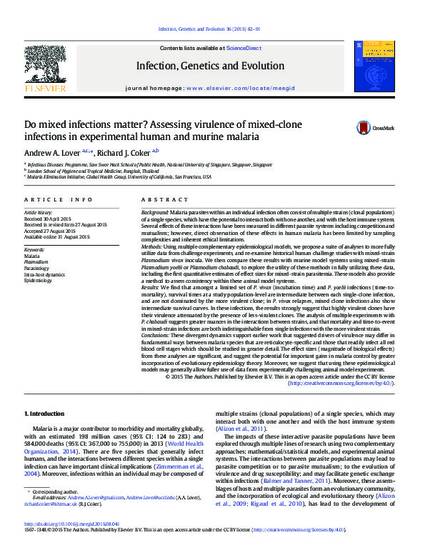
Article
Do mixed infections matter? Assessing virulence of mixed-clone infections in experimental human and murine malaria
Infection, Genetics and Evolution
(2015)
Abstract
p.p1 {margin: 0.0px 0.0px 0.0px 0.0px; font: 7.0px Times; color: #141413} span.s1 {font: 7.0px Helvetica}
Background: Malaria parasites within an individual infection often consist of multiple strains (clonal populations) of a single species, which have the potential to interact both with one another, and with the host immune system. Several effects of these interactions have been measured in different parasite systems including competition and mutualism; however, direct observation of these effects in human malaria has been limited by sampling complexities and inherent ethical limitations.
Methods: Using multiple complementary epidemiological models, we propose a suite of analyses to more fully utilize data from challenge experiments, and re-examine historical human challenge studies with mixed-strain Plasmodium vivax inocula. We then compare these results with murine model systems using mixed-strain Plasmodium yoelii or Plasmodium chabaudi, to explore the utility of these methods in fully utilizing these data, including the first quantitative estimates of effect sizes for mixed-strain parasitemia. These models also provide a method to assess consistency within these animal model systems.
Results: We find that amongst a limited set of P. vivax (incubation time) and P. yoelii infections (time-to- mortality), survival times at a study population-level are intermediate between each single-clone infection, and are not dominated by the more virulent clone; in P. vivax relapses, mixed clone infections also show intermediate survival curves. In these infections, the results strongly suggest that highly virulent clones have their virulence attenuated by the presence of less-virulent clones. The analysis of multiple experiments with P. chabaudi suggests greater nuances in the interactions between strains, and that mortality and time-to-event in mixed-strain infections are both indistinguishable from single infections with the more virulent strain. Conclusions: These divergent dynamics support earlier work that suggested drivers of virulence may differ in fundamental ways between malaria species that are reticulocyte-specific and those that readily infect all red blood cell stages which should be studied in greater detail. The effect sizes (magnitude of biological effects) from these analyses are significant, and suggest the potential for important gains in malaria control by greater incorporation of evolutionary epidemiology theory. Moreover, we suggest that using these epidemiological models may generally allow fuller use of data from experimentally challenging animal model experiments.
Keywords
- malaria,
- Plasmodium vivax,
- Plasmodium yoelli,
- Experimental infections,
- Malariotherapy
Disciplines
Publication Date
Summer 2015
Citation Information
Andrew A. Lover and Richard Coker. "Do mixed infections matter? Assessing virulence of mixed-clone infections in experimental human and murine malaria" Infection, Genetics and Evolution Vol. 36 (2015) p. 82 - 91 Available at: http://works.bepress.com/andrew-lover/22/
